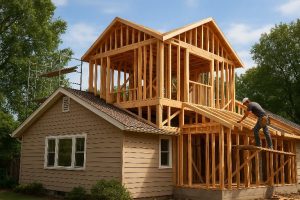What is the first thing that people notice when they see your house? For many Americans, the answer is the garage. That’s because garages take up a large amount of real estate and are usually situated in a visible area.
How Design a Garage for Your Home: A Comprehensive Guide
The garage is not merely a space to park your car; it’s an extension of your home that can serve various purposes. Whether you’re looking to create a functional storage area, a DIY workshop, or an organized parking space, designing your garage requires thoughtful planning and consideration. This comprehensive guide will take you through the essential steps and creative ideas to help you design a garage that not only meets your practical needs but also enhances the overall aesthetics of your home.
Step 1: Assess Your Needs
- Parking Space Requirements:
Determine the number of vehicles you need to accommodate. Consider any future additions to your vehicle fleet when planning the size of the garage. - Functional Requirements:
Identify the specific functions you want the garage to serve – storage, workshop, gym, or a combination of these. This will guide the layout and organization of the space.
Step 2: Plan the Layout
- Optimize Storage Space:
Utilize vertical space with wall-mounted shelves and cabinets. Consider overhead storage solutions to keep the floor clutter-free. - Workshop Design:
If you plan to use the garage as a workshop, allocate a dedicated area for tools, workbenches, and storage for materials. - Multipurpose Zones:
Designate zones for different purposes, ensuring a well-organized and versatile space that can adapt to your evolving needs.
Step 3: Choose the Right Flooring
- Durable and Easy to Clean:
Opt for durable flooring options like epoxy or concrete that can withstand heavy use and are easy to clean. - Non-Slip Surfaces:
Ensure safety by choosing non-slip surfaces, especially if the garage is used as a workshop where spills may occur.
Step 4: Invest in Quality Lighting
- Task Lighting:
Install focused task lighting in workshop areas and above workbenches to illuminate specific areas effectively. - Overall Illumination:
Ensure overall brightness with overhead lighting to create a well-lit and inviting space.
Step 5: Security and Access
- Secure Entry Points:
Invest in sturdy doors and windows, and consider a security system to safeguard your belongings. - Convenient Access:
Plan for easy access from the garage to the main house, ensuring convenience in daily activities.
Step 6: Aesthetics and Exterior Design
- Match the Home’s Aesthetic:
Choose exterior materials and colors that complement the overall design of your home for a cohesive look. - Landscaping Considerations:
Integrate landscaping elements around the garage to enhance its visual appeal and blend it seamlessly with the surroundings.
Step 7: Regular Maintenance
- Organize Regular Cleanouts:
Schedule periodic cleanouts and decluttering sessions to maintain an organized and functional space. - Inspect for Repairs:
Regularly inspect the garage for any maintenance or repair needs to ensure its longevity and functionality.
By following these steps and incorporating creative ideas into your garage design, you can transform this space into a valuable and versatile extension of your home. From functional storage solutions to a well-lit workshop, your garage can become an organized and aesthetically pleasing area that adds both practical and visual value to your home.
Types of Garages
The most common kinds of garages are attached garages, detached garages, and carports. Attached garages are garages that are attached to a house, as their name would suggest. A detached garage, on the other hand, is completely separate from the house.
Carports are not complete garages, but they offer some shelter from the elements by providing a roof that you can park your car under.
If you are looking to add a garage to a completely garageless house, a detached garage is your best bet. You can buy prefab kits to construct these garages, and since they are not attached to the home they are easier to fit onto your property and quickly complete.
Garage Materials
The materials you use for your garage have a huge effect on the look of the space and the ways that you can use it. Your garage design can skew utilitarian if you plan to use it for car storage or as a workspace. Concrete floors and steel doors are durable and cost-effective.
If you want to relax in your garage or use it as a hangout area, you might opt for fancier materials. A wood or fiberglass door adds a nice touch to an otherwise plain garage, and floor tiles can create a nice flooring look without compromising durability. You can also consider the Garage Force process, which offers a strong floor coating that takes concrete surfaces to the next level.
Transform Your Garage Today
With a few materials and a bit of imagination, you can take your garage from boring to beautiful! Transform your home by starting with your garage. You’ll be amazed at the difference that it makes.
Now that you know how to design a garage for your home, check out our site to get inspiration for your next project. Our home improvement articles cover landscaping, pool cleaning, interior design, and more!






